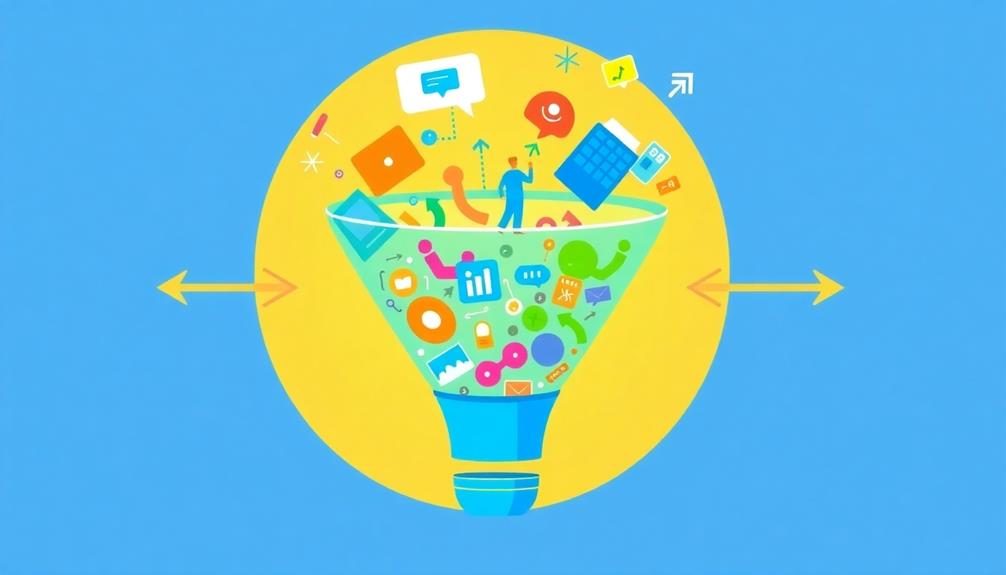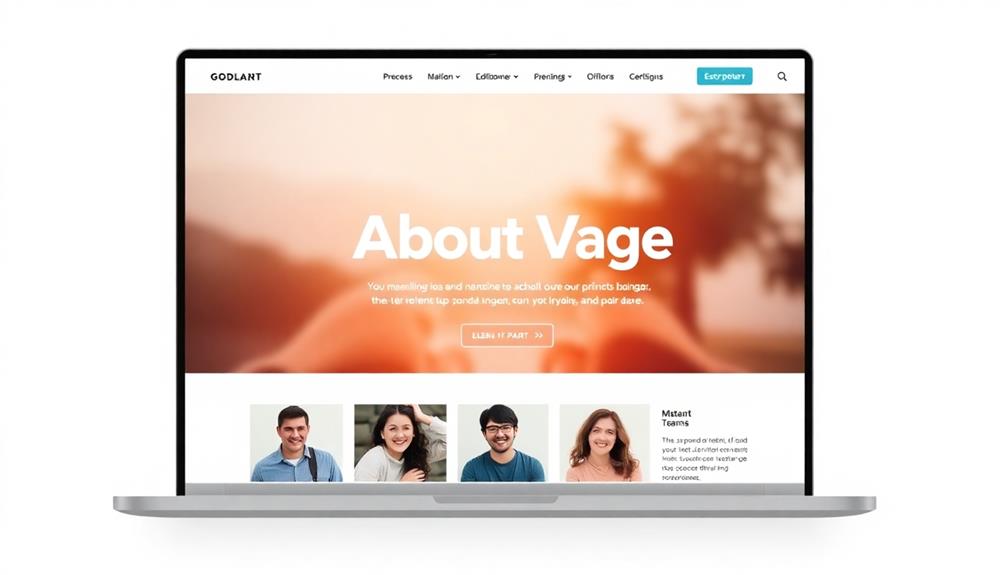To create a sales funnel that converts, you need to guide prospects through four key stages: Awareness, Interest, Decision, and Action. Start by defining your target audience and crafting compelling content that resonates with their needs. Use strong visual elements and clear calls to action to keep them engaged. Optimize your landing pages for speed and mobile responsiveness. Regularly analyze your funnel's performance to identify drop-off points and fix leaks. Remember, a customer-centric approach will foster deeper connections and boost conversions. There's much more to refine your strategy effectively, so let's explore the next steps together.
Key Takeaways
- Define your target audience by creating detailed buyer personas to tailor your messaging effectively.
- Craft compelling content with strong calls to action (CTAs) to guide customers through each funnel stage.
- Optimize landing pages with clear value propositions and ensure mobile responsiveness for better user experiences.
- Nurture leads through segmented email campaigns and timely follow-ups to boost engagement and conversion rates.
- Continuously analyze funnel performance through A/B testing and user behavior tracking to identify improvement opportunities.
Understanding Sales Funnels
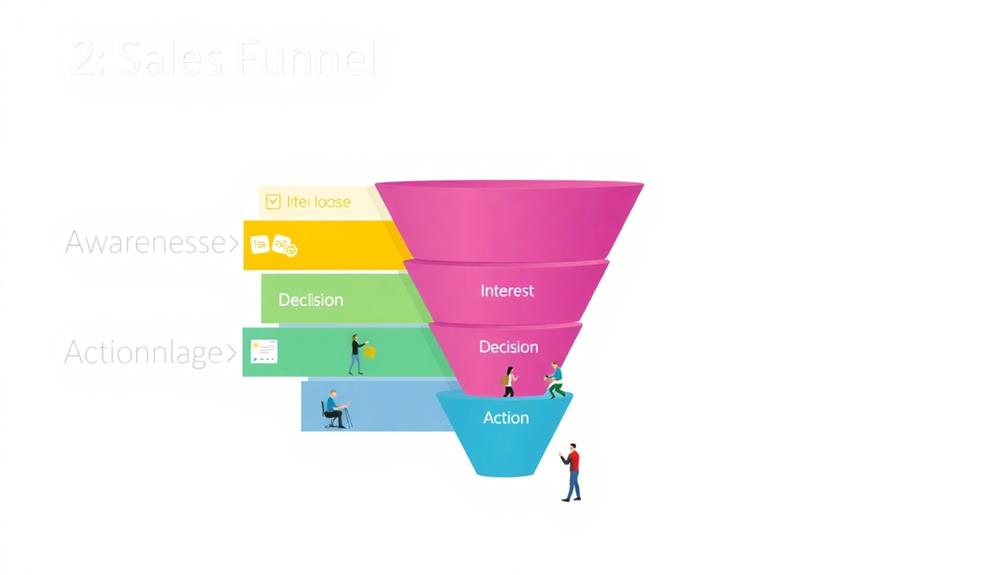
When you think about the customer journey, envision a sales funnel that guides potential buyers from awareness to action. Understanding sales funnels is imperative for any business looking to improve its sales process. A well-structured sales funnel consists of four primary stages: Awareness, Interest, Decision, and Action. Each stage plays a critical role in determining how effectively you can convert potential customers into paying ones.
Incorporating advanced technologies like Natural Language Processing (NLP) can greatly enhance customer interactions at each stage, providing personalized experiences that keep potential buyers engaged.
To optimize your funnel, it's important to monitor key metrics like conversion rates and drop-off rates. By identifying where potential customers lose interest, you can implement targeted strategies to keep them engaged. The average sales close rate is about 29%, which underscores the importance of refining your funnel. If you're not tracking these metrics, you might miss opportunities to enhance your customer journey.
Continuous optimization allows you to adapt and improve your sales funnel, ensuring a higher likelihood of converting leads at each stage. Investing time in understanding sales funnels not only boosts your conversion rates but also enhances customer lifetime value.
Ultimately, the better you understand your funnel, the more successful your sales process will be.
Key Stages of a Funnel
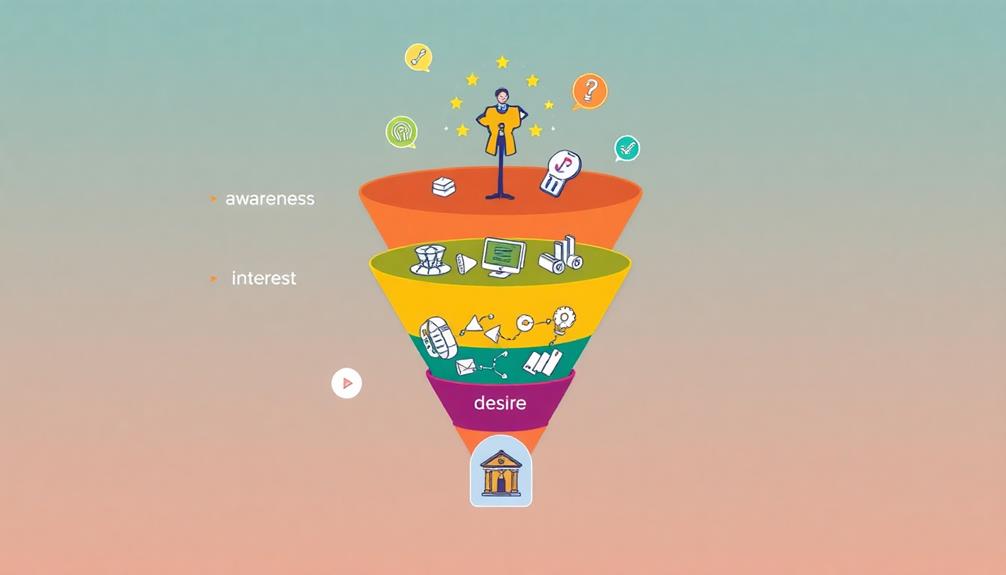
How do you effectively navigate the key stages of a sales funnel? Understanding the sales funnel stages is essential for guiding prospects through the conversion process. Here's a breakdown of the key stages:
| Stage | Focus |
|---|---|
| Awareness | Potential customers discover your product through ads and landing pages. |
| Interest | Prospects engage with your content and evaluate your offerings. |
| Decision | Customers compare options and need clear value propositions. |
| Action | Prospects complete a purchase or exit the funnel. |
At the top of the funnel, your goal is to attract attention. In the Interest stage, keep them engaged with relevant information. When they reach the Decision stage, it's vital to highlight incentives that can tip the scales in your favor. Finally, in the Action stage, you must minimize friction in the checkout process to increase conversion rates.
Utilizing customer journey maps helps you visualize each stage, ensuring your messaging aligns with what your prospects need at each point. By focusing on these key stages, you can create a sales funnel that effectively moves customers toward a purchase.
Defining Your Target Audience
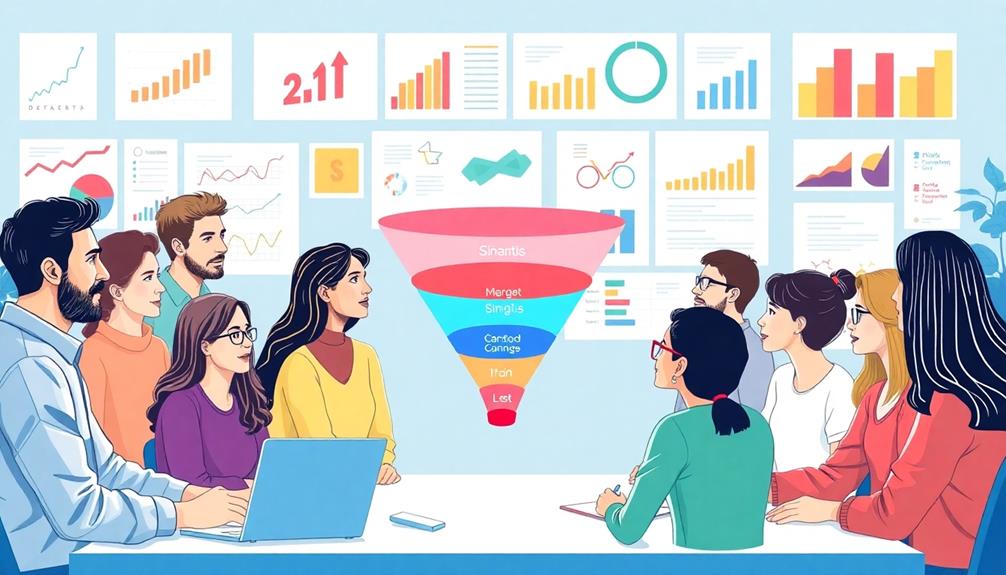
Understanding your target audience is an essential step in optimizing your sales funnel. Start by researching demographics, psychographics, and behavior data to create detailed buyer personas that represent your ideal customers. This helps you identify audience pain points and needs, which are significant for crafting effective marketing strategies.
Additionally, utilizing data-driven marketing strategies can further enhance your understanding of your audience's preferences and behaviors. Keep in mind that 70% of consumers prefer brands that personalize their marketing efforts based on their interests and behaviors.
Segmenting your audience allows for tailored marketing strategies, leading to a remarkable 760% increase in revenue from segmented campaigns compared to non-segmented ones. Identify preferred communication channels and content types to guarantee your marketing messages reach your audience effectively.
With 78% of consumers responding better to personalized messages, it's crucial to communicate in ways that resonate with them.
Crafting Compelling Content
Crafting compelling content is all about engaging your audience with targeted messaging that speaks directly to their needs.
By focusing on transformative journeys of success and resilience, you can create a deeper connection with your audience.
Incorporating visual elements can make your content more appealing, while strong calls to action can guide potential customers through the sales funnel.
Engaging Visual Elements
Incorporating engaging visual elements into your sales funnel is essential for capturing attention and driving conversions. Research shows that using visuals like infographics and videos can boost user engagement by up to 94%.
Additionally, incorporating aesthetically pleasing hooks and wall organization can enhance the overall presentation of your sales materials. To make the most of these elements, include strong calls-to-action (CTAs) within your visual content; doing so can improve conversion rates by 80%, guiding users toward the next steps in their journey.
High-quality images and professional design not only enhance perceived value but also shape consumer perceptions of your brand's credibility. In fact, 75% of consumers admit to making judgments based on visual content.
To maximize effectiveness, consider A/B testing various visual elements, such as colors and layouts. This can lead to a 10-20% increase in conversion rates by identifying what resonates best with your audience.
Targeted Messaging Strategies
Visual elements grab attention, but it's the messaging that keeps potential customers engaged and drives them toward conversion. To craft effective targeted messaging, start by understanding your audience's pain points and preferences. This insight allows you to create content that resonates directly with their needs and desires.
Implementing segmentation techniques, as seen in Mailchimp features, for different buyer personas can markedly enhance engagement; personalized messages can lead to a 20% increase in conversion rates. Incorporate social proof, like customer testimonials and case studies, to build trust and credibility—this can increase the likelihood of conversion by 63%.
Don't forget about the power of strong calls-to-action (CTAs) within your content. While we'll discuss CTAs in detail later, remember that optimized CTAs can improve click-through rates by up to 371%.
Regular A/B testing of your messaging strategies is essential. It allows you to make data-driven adjustments and identify the most effective content variations that drive higher engagement and conversion rates.
Calls to Action
When it comes to driving conversions, a compelling call to action (CTA) is essential. Your CTAs should be clear, concise, and action-oriented, prompting users to take the desired step. Incorporating urgency can notably boost conversion rates. For example, phrases like "Limited Time Offer" can encourage immediate action from your website visitors.
To optimize your CTAs, consider A/B testing different variations. This method reveals what resonates with your audience and can improve conversions by 20% or more. Here's a simple breakdown of effective CTA strategies:
| Strategy | Description |
|---|---|
| Clarity | Use straightforward language like "Sign Up Now." |
| Urgency | Add urgency with phrases like "Only 2 Left!" |
| Visual Design | Use contrasting colors for CTA buttons. |
| Personalization | Tailor CTAs to users, e.g., "Welcome Back, [Name]!" |
| A/B Testing | Test different CTAs to see what converts best. |
Designing Effective Landing Pages
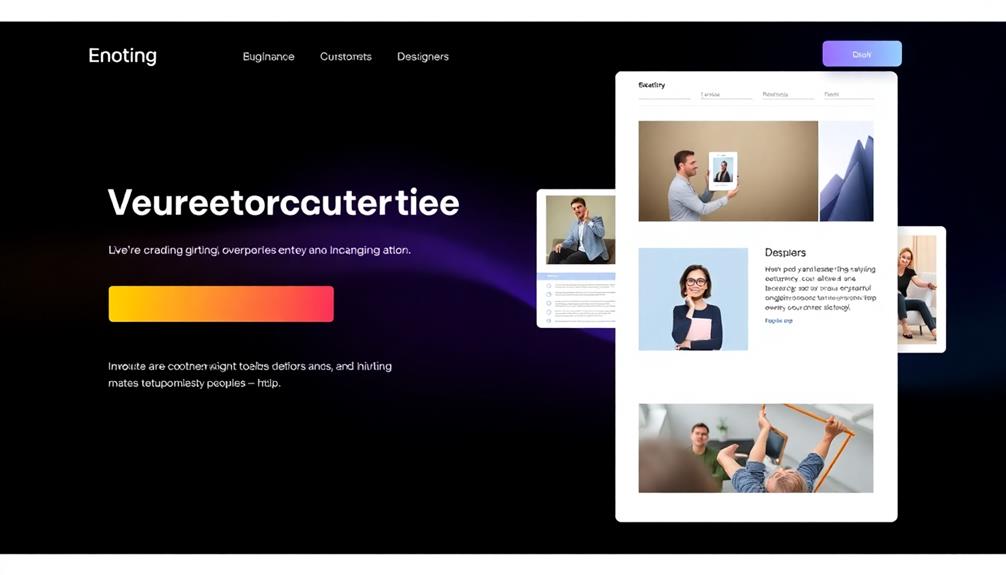
Creating an effective landing page is essential for converting visitors into customers. Start by crafting a clear value proposition that immediately grabs attention; remember, 73% of users skim content.
Your landing page should also include strong calls-to-action (CTAs) that resonate with your audience. Personalized CTAs can boost conversion rates by 202%, so tailor them to fit your visitors' needs. To attract abundance in your sales funnel, consider incorporating Abraham's Business Success Principles that emphasize a positive mindset and clear intentions.
Load speed is another vital factor; even a one-second delay can cut conversions by 7%. Make sure your design is fast-loading to keep users engaged.
Additionally, A/B testing different elements, such as headlines or images, can lead to a 49% improvement in conversion rates. This iterative optimization helps you discover what works best for your audience.
Don't forget about mobile responsiveness. With mobile devices accounting for 54.8% of global website traffic, it's essential that your landing page looks and functions seamlessly across all devices.
Nurturing Leads Through Email
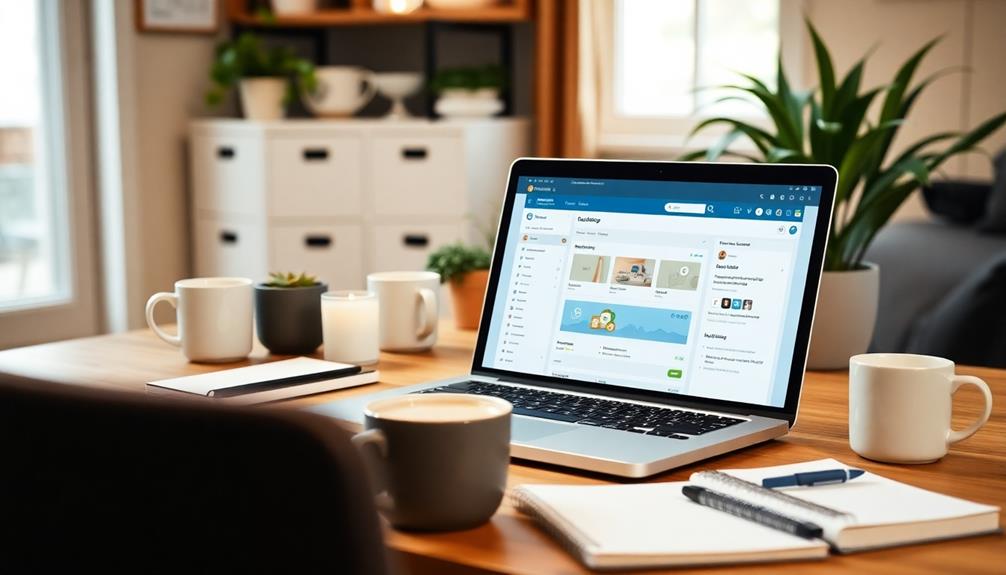
After attracting visitors with an optimized landing page, the next step is to nurture those leads through effective email marketing. This approach can generate an impressive average return on investment of $42 for every dollar spent, making it an essential part of your sales funnel.
One effective strategy is segmenting your email list, allowing you to send targeted messages that resonate with specific audience groups. This personalization can lead to a 26% increase in open rates and considerably boost conversion rates. Incorporating elements of audience engagement strategies can further enhance your email campaigns and create a more compelling experience for your leads.
Implementing drip campaigns is another powerful tactic. By sending a series of automated emails based on user behavior, you can increase engagement rates by as much as 80%.
It's imperative to communicate with leads promptly; following up within the first hour of their inquiry can boost conversion likelihood by up to seven times.
Analyzing Funnel Performance
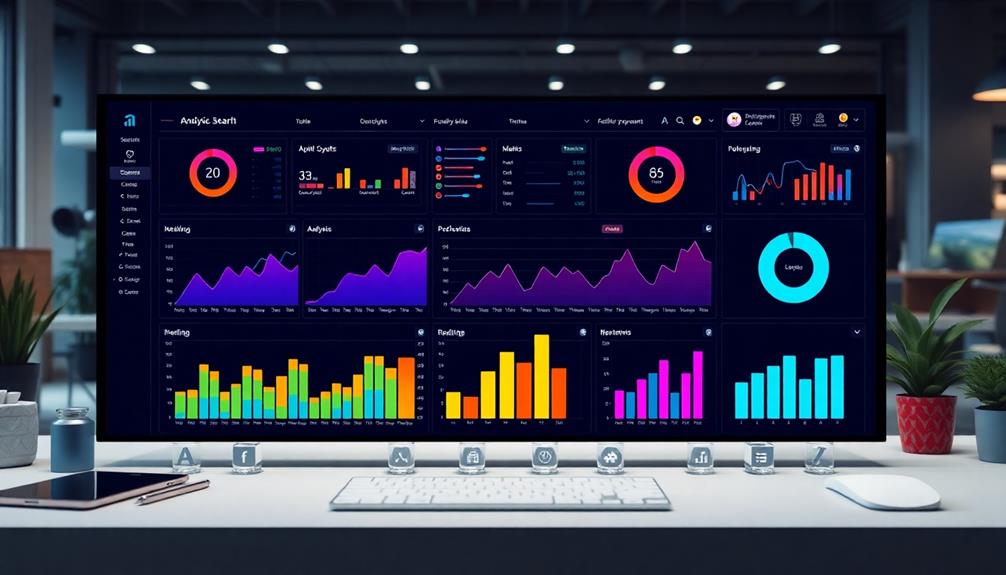
To optimize your sales funnel effectively, you need to analyze its performance by tracking key metrics such as conversion rates, drop-off rates, and customer lifetime value. Understanding these metrics helps you gauge how well each stage of your conversion funnel operates.
Tools like Google Analytics provide valuable insights into user behavior, traffic sources, and exit pages, enabling you to make targeted optimizations. Additionally, monitoring credit card insights can reveal customer spending behaviors that may influence your funnel's performance.
Here are four essential steps to analyze your funnel performance:
- Track Conversion Rates: Measure the percentage of visitors who complete desired actions at each stage of your funnel.
- Monitor Drop-Off Rates: Identify where potential customers are exiting the funnel, which can highlight problem areas.
- Utilize A/B Testing: Experiment with different elements, like landing pages and CTAs, to find variations that boost conversion rates.
- Compare Historical Data: Regularly assess current metrics against past performance to spot trends and measure the impact of any changes.
Identifying and Fixing Leaks

To effectively identify and fix leaks in your sales funnel, start by analyzing your traffic sources. Understanding where your visitors come from can reveal which channels are underperforming.
Additionally, examining challenges faced by startups can provide insights into common pitfalls that may be affecting your conversion rates.
Next, streamline your navigation process to guarantee users can easily move through each stage without frustration.
Analyzing Traffic Sources
Analyzing traffic sources is essential for pinpointing where your potential customers are dropping off in the sales funnel. By understanding which channels drive the most qualified leads, you can effectively focus your marketing efforts.
Implementing AI-powered tools can greatly enhance your ability to analyze data trends and optimize your funnel strategy, as seen in AI in Marketing.
Here are four steps to help you analyze traffic sources:
- Utilize Analytics Tools: Use Google Analytics to track metrics like bounce rates and conversion rates from different traffic sources. This data reveals how well each channel performs.
- Monitor User Behavior: Identify funnel leaks by observing user behavior at each stage. Funnel reports can help visualize where drop-offs occur, highlighting potential obstacles in the customer journey.
- Review High-Traffic Exit Pages: Regularly check your high-traffic exit pages. These insights can prompt adjustments that improve conversion rates and keep users engaged.
- Implement A/B Testing: Test different landing pages to see which traffic sources yield the highest conversion rates. This data-driven approach allows you to refine your marketing strategies effectively.
Streamlining Navigation Process
Understanding where users drop off in your sales funnel lays the groundwork for streamlining your navigation process. Start by analyzing user behavior through session recordings. This helps pinpoint specific navigation issues that lead to drop-off rates, especially on high-traffic exit pages. Identifying these pages through analytics is essential for effective optimization.
Next, simplify your menu structure. Reducing the number of clicks required to reach key content can markedly enhance user experience and minimize drop-off rates. Make sure your calls-to-action (CTAs) are clear and concise, guiding users toward desired conversion steps. This improvement can boost overall funnel performance.
Don't forget to engage in regular A/B testing of your navigation changes. Testing different layouts and paths reveals what keeps users engaged and leads to higher conversion rates.
Continuous Optimization Strategies
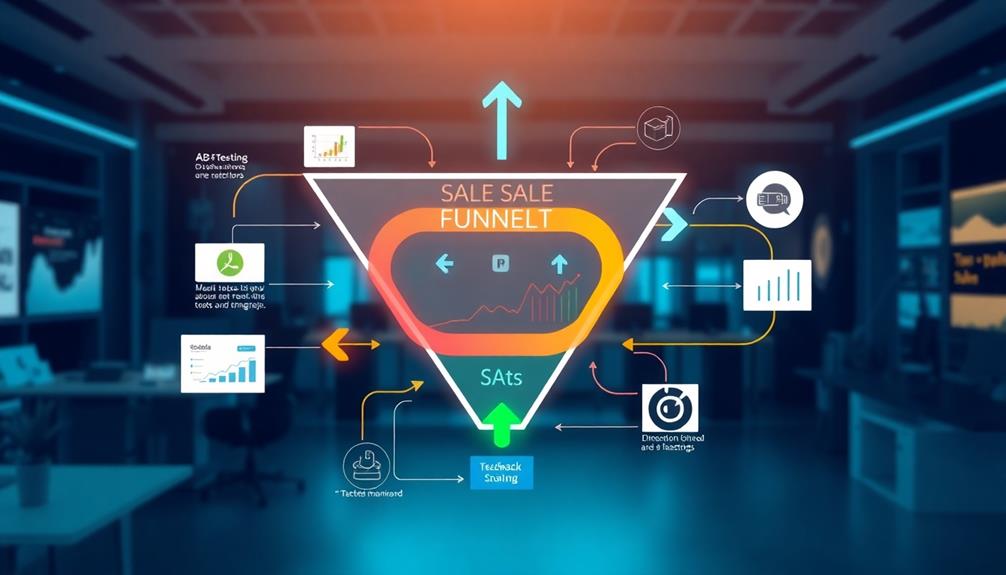
While your sales funnel may seem effective at first glance, continuous optimization is essential for maximizing its potential. By regularly analyzing performance metrics, you can uncover insights that enhance your conversion rates and overall effectiveness.
Here are four key strategies to implement:
- A/B Testing: Experiment with different headlines, CTAs, and landing page designs. This helps you find what resonates best with your audience and drives higher conversions.
- Utilize Customer Feedback: Gather insights from tools like Google Analytics to understand user behavior. Addressing pain points that may hinder conversions is important for improvement.
- Refine Content: Continuously update and optimize your content throughout the funnel stages. Keeping it relevant and engaging is essential for nurturing leads and guiding them toward a purchase.
- Monitor User Interactions: Use heatmaps and session recordings to observe how users interact with your funnel. This real-time data helps identify opportunities for optimization in your marketing efforts.
Embracing a Customer-Centric Approach
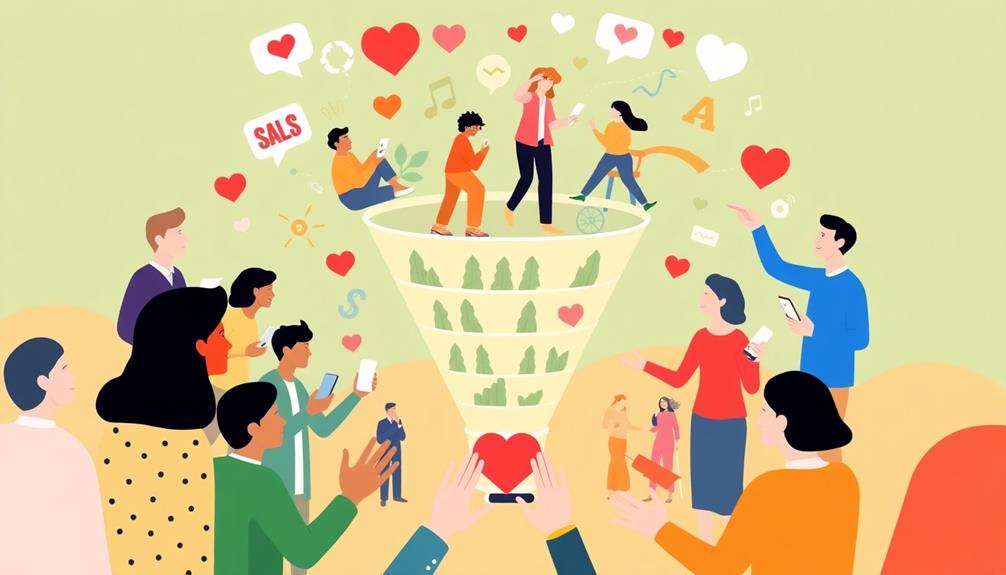
To create a successful sales funnel, you need to understand your visitors' needs and preferences.
By implementing personalized engagement strategies, you can connect with potential customers on a deeper level.
Streamlining the user experience not only keeps them engaged but also increases your chances of conversion.
Understanding Visitor Needs
Every successful sales funnel starts with a keen awareness of visitor needs. When you understand what your audience wants, you can create tailored experiences that resonate with them.
In fact, 70% of consumers feel more connected to brands that recognize their needs. Here are four strategies to help you grasp visitor needs:
1. Conduct Audience Research: Explore the pain points and motivations of your target market.
63% of consumers say personalized experiences boost their purchase likelihood.
2. Utilize Data Analytics: Use tools to track visitor behavior and preferences.
Companies that leverage data-driven marketing see a 5-8 times higher ROI.
3. Create Buyer Personas: Develop detailed profiles based on demographic, psychographic, and behavioral data.
This guarantees your messaging hits the mark, enhancing engagement.
4. Implement Customer Feedback: Engage with your audience through surveys and reviews.
With 90% of consumers trusting peer recommendations, adapting your offerings based on real insights can greatly improve your sales funnel.
Personalized Engagement Strategies
Personalized engagement strategies are essential for creating meaningful connections with your audience. By leveraging customer data, you can craft tailored messaging that resonates with specific audience segments, boosting conversion rates by up to 202%. Sending targeted offers based on browsing behavior and purchase history not only enhances engagement but also personalizes the shopping experience.
Implementing dynamic content on your landing pages can greatly improve user experience, leading to a 25% increase in conversion rates. This strategy addresses the unique needs of different visitor segments, ensuring they feel understood and valued.
Email marketing campaigns play a critical role, too. By using personalized subject lines and content, you can achieve 29% higher open rates and 41% higher click-through rates compared to generic messaging. This approach keeps your audience engaged and more likely to convert.
Incorporating customer feedback and satisfaction surveys into your engagement strategy is another effective tactic. This not only builds trust but also promotes customer retention, leading to a 70% increase in loyalty.
Streamlining User Experience
Streamlining user experience is essential for maximizing conversion rates and ensuring customers feel valued throughout their journey. To achieve this, you should focus on the following key strategies:
- Analyze User Behavior: Utilize tools like Hotjar to understand common entry and drop-off points in your sales funnel. This insight helps you identify areas for improvement.
- Enhance Landing Pages: Create user-friendly, visually appealing landing pages with clear messaging and fast loading times. This reduces bounce rates and encourages visitors to continue down the funnel.
- Strong Calls-to-Action: Implement targeted content and strong calls-to-action (CTAs) that guide users seamlessly through the funnel. This fosters engagement and boosts conversion rates.
- Gather Feedback & Monitor Metrics: Regularly collect customer feedback and track performance metrics. This allows you to pinpoint pain points in the customer journey and make timely adjustments to enhance user satisfaction.
Frequently Asked Questions
How to Build a Funnel That Converts?
To build a funnel that converts, start by identifying your audience and crafting tailored messages. Make your landing pages appealing, use engaging content, nurture leads effectively, and monitor performance to optimize your funnel continuously.
How Do You Create an Automated Sales Funnel?
To create an automated sales funnel, you'll first map out the customer journey, then utilize marketing automation tools to nurture leads. Capture visitor information with enticing offers, and analyze performance metrics for continuous improvement.
What Is a Conversion Funnel?
A conversion funnel's the journey your potential customers take, from discovering your product to making a purchase. You need to guide them through each stage, optimizing their experience to increase conversions and reduce drop-offs.
How Do I Build My Own Sales Funnel?
Building your sales funnel is like planting a garden. Start by identifying your audience, then create engaging content and nurturing strategies. Monitor growth, adapt to feedback, and watch your leads blossom into loyal customers.
Conclusion
Creating a sales funnel that converts is like planting a garden. You've got to prepare the soil, choose the right seeds, and nurture them carefully. Just like a gardener adjusts their watering and sunlight based on what the plants need, you must analyze and optimize your funnel regularly. With patience and persistence, your efforts will blossom into fruitful conversions, turning prospects into loyal customers who keep coming back for more. So, get planting!

